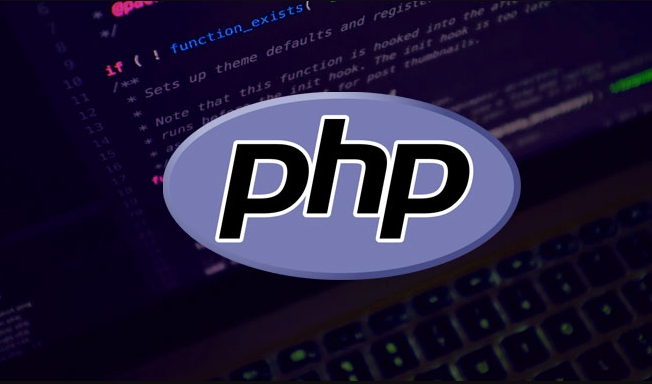Annotations are crucial in PHP development, and reasonable annotations can improve code readability and maintenance. When choosing an annotation method, 1. Single-line comments (// or #) are suitable for explaining single-line code or temporary blocking code; 2. Multi-line comments (/ .../) are suitable for explaining function, class or file header information, but nested use should be avoided. 3. It is recommended to write DocBlock comments for functions and classes to clarify the purpose, parameters and return values to support IDE prompts and document generation. 4. Comments need to be modified synchronously as the code is updated to delete useless comments to prevent misleading. 5. Complex logic should be explained "why" rather than just describing operations. 6. The comments should be concise and clear, avoid lengthy and nonsense, and it is recommended to use Chinese writing. Although good annotation habits are small, they can significantly improve the quality of the code.

Comments are the most easily overlooked part when writing code, but they are an important tool to make the code more readable and more maintainable. As a widely used backend language, PHP not only helps you clarify the logic, but also makes team collaboration smoother.

Single-line comment vs Multi-line comment: How to choose?
In PHP, there are three commonly used annotation methods: // , # and /* */ .
- Single-line comments (
//or#) are suitable for explaining the role of a certain line of code, or temporarily blocking a piece of code. - Multi-line comments (
/* ... */) are more suitable for explaining function functions, class functions, or file header information.
suggestion:

- For a brief description
// - Descriptions above functions or classes use multi-line comments
- Avoid nesting use of
/* */, making errors prone
Comments to functions and classes: Don't skip DocBlock
Many developers only write function codes and not comments when writing functions. But in team development, a clear function annotation can save a lot of communication costs.
It is recommended to use DocBlock format to write function comments, for example:

/**
* Calculate total user points*
* @param int $userId User ID
* @return int User current points*/
function calculateUserPoints($userId) {
// ...
}benefit:
- Supports IDE automatic prompt parameters and return values
- You can use tools to generate documents (such as phpDocumentor)
- Improve code maintainability
Even for a small function, it is recommended to write the purpose, parameter meaning and return value type.
Comments need to be updated, don't let them "invalid"
It is one of the most common problems to just leave the comments alone. For example, if a certain paragraph has been changed, but the comments are still stuck in the old version, this will mislead readers.
suggestion:
- When modifying the code, check whether the relevant comments need to be updated.
- Remove useless old comments and avoid "garbage comments"
- For complex logic, you can explain "why" instead of "what was done" in the comments
For example:
// Use regular replacement to be compatible with old data formats
Such comments are more valuable than "replace strings".
Writing comments is not writing essays, just be clear
Some people think that the notes must be written as rigorously as the instruction manual, but it is actually unnecessary. The key is to express the intention clearly without pursuing literary talent.
Note:
- Don't write nonsense, such as "set variable to true"
- Try to write comments in Chinese (unless it is an international team)
- Control the comment ratio, not longer than the code
Basically that's it. Good annotation habits don't take much time, but in the long run, it will greatly improve the quality of your code.
The above is the detailed content of Essential PHP Commenting Tips. For more information, please follow other related articles on the PHP Chinese website!

Hot AI Tools

Undress AI Tool
Undress images for free

Undresser.AI Undress
AI-powered app for creating realistic nude photos

AI Clothes Remover
Online AI tool for removing clothes from photos.

Clothoff.io
AI clothes remover

Video Face Swap
Swap faces in any video effortlessly with our completely free AI face swap tool!

Hot Article

Hot Tools

Notepad++7.3.1
Easy-to-use and free code editor

SublimeText3 Chinese version
Chinese version, very easy to use

Zend Studio 13.0.1
Powerful PHP integrated development environment

Dreamweaver CS6
Visual web development tools

SublimeText3 Mac version
God-level code editing software (SublimeText3)

Hot Topics
 Object-Relational Mapping (ORM) Performance Tuning in PHP
Jul 29, 2025 am 05:00 AM
Object-Relational Mapping (ORM) Performance Tuning in PHP
Jul 29, 2025 am 05:00 AM
Avoid N 1 query problems, reduce the number of database queries by loading associated data in advance; 2. Select only the required fields to avoid loading complete entities to save memory and bandwidth; 3. Use cache strategies reasonably, such as Doctrine's secondary cache or Redis cache high-frequency query results; 4. Optimize the entity life cycle and call clear() regularly to free up memory to prevent memory overflow; 5. Ensure that the database index exists and analyze the generated SQL statements to avoid inefficient queries; 6. Disable automatic change tracking in scenarios where changes are not required, and use arrays or lightweight modes to improve performance. Correct use of ORM requires combining SQL monitoring, caching, batch processing and appropriate optimization to ensure application performance while maintaining development efficiency.
 Building Immutable Objects in PHP with Readonly Properties
Jul 30, 2025 am 05:40 AM
Building Immutable Objects in PHP with Readonly Properties
Jul 30, 2025 am 05:40 AM
ReadonlypropertiesinPHP8.2canonlybeassignedonceintheconstructororatdeclarationandcannotbemodifiedafterward,enforcingimmutabilityatthelanguagelevel.2.Toachievedeepimmutability,wrapmutabletypeslikearraysinArrayObjectorusecustomimmutablecollectionssucha
 Laravel raw SQL query example
Jul 29, 2025 am 02:59 AM
Laravel raw SQL query example
Jul 29, 2025 am 02:59 AM
Laravel supports the use of native SQL queries, but parameter binding should be preferred to ensure safety; 1. Use DB::select() to execute SELECT queries with parameter binding to prevent SQL injection; 2. Use DB::update() to perform UPDATE operations and return the number of rows affected; 3. Use DB::insert() to insert data; 4. Use DB::delete() to delete data; 5. Use DB::statement() to execute SQL statements without result sets such as CREATE, ALTER, etc.; 6. It is recommended to use whereRaw, selectRaw and other methods in QueryBuilder to combine native expressions to improve security
 css dark mode toggle example
Jul 30, 2025 am 05:28 AM
css dark mode toggle example
Jul 30, 2025 am 05:28 AM
First, use JavaScript to obtain the user system preferences and locally stored theme settings, and initialize the page theme; 1. The HTML structure contains a button to trigger topic switching; 2. CSS uses: root to define bright theme variables, .dark-mode class defines dark theme variables, and applies these variables through var(); 3. JavaScript detects prefers-color-scheme and reads localStorage to determine the initial theme; 4. Switch the dark-mode class on the html element when clicking the button, and saves the current state to localStorage; 5. All color changes are accompanied by 0.3 seconds transition animation to enhance the user
 Java Authentication and Authorization with JWT
Jul 29, 2025 am 12:07 AM
Java Authentication and Authorization with JWT
Jul 29, 2025 am 12:07 AM
JWT is an open standard for safe transmission of information. In Java, authentication and authorization can be achieved through the JJWT library. 1. Add JJWT API, Impl and Jackson dependencies; 2. Create JwtUtil tool class to generate, parse and verify tokens; 3. Write JwtFilter intercepts requests and verify BearerTokens in Authorization header; 4. Register Filter in SpringBoot to protect the specified path; 5. Provide a login interface to return JWT after verifying the user; 6. The protected interface obtains user identity and roles through parsing the token for access control, and ultimately realizes a stateless and extensible security mechanism, suitable for distributed systems.
 go by example generics
Jul 29, 2025 am 04:10 AM
go by example generics
Jul 29, 2025 am 04:10 AM
Go generics are supported since 1.18 and are used to write generic code for type-safe. 1. The generic function PrintSlice[Tany](s[]T) can print slices of any type, such as []int or []string. 2. Through type constraint Number limits T to numeric types such as int and float, Sum[TNumber](slice[]T)T safe summation is realized. 3. The generic structure typeBox[Tany]struct{ValueT} can encapsulate any type value and be used with the NewBox[Tany](vT)*Box[T] constructor. 4. Add Set(vT) and Get()T methods to Box[T] without
 python parse date string example
Jul 30, 2025 am 03:32 AM
python parse date string example
Jul 30, 2025 am 03:32 AM
Use datetime.strptime() to convert date strings into datetime object. 1. Basic usage: parse "2023-10-05" as datetime object through "%Y-%m-%d"; 2. Supports multiple formats such as "%m/%d/%Y" to parse American dates, "%d/%m/%Y" to parse British dates, "%b%d,%Y%I:%M%p" to parse time with AM/PM; 3. Use dateutil.parser.parse() to automatically infer unknown formats; 4. Use .d
 python json loads example
Jul 29, 2025 am 03:23 AM
python json loads example
Jul 29, 2025 am 03:23 AM
json.loads() is used to parse JSON strings into Python data structures. 1. The input must be a string wrapped in double quotes and the boolean value is true/false; 2. Supports automatic conversion of null→None, object→dict, array→list, etc.; 3. It is often used to process JSON strings returned by API. For example, response_string can be directly accessed after parsing by json.loads(). When using it, you must ensure that the JSON format is correct, otherwise an exception will be thrown.






